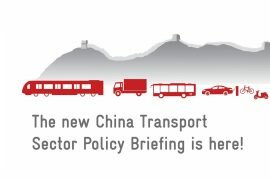China Transport Sector Policy Briefing – 2019, Issue 3
 The newest issue of our China Transport Sector Policy Briefing is here! The Sustainable Mobility Team at GIZ in China provides you with regular summaries of important policies in China’s transport sector.
The newest issue of our China Transport Sector Policy Briefing is here! The Sustainable Mobility Team at GIZ in China provides you with regular summaries of important policies in China’s transport sector.
Please click here to download: China Transport Sector Policy Briefing Issue 3 2019
NEV purchase subsidies, VAT reform, methanol-fuelled cars, green logistics
On 5 March 2019, Premier Li Keqiang presented the 2019 Government Work Report at the National People’s Congress. Each year, the Government Work Report summarises economic and social achievements from the previous year and the general direction for the current fiscal year. For the transport sector, the 2019 Report reiterates many of the goals set out in policies previously and names several key topics, such as innovation and research in the field of Big Data, Artificial Intelligence and mobility. As for investments in transport infrastructure, the Report sets concrete targets: 800 billion RMB (ca. 100 billion EUR) will be invested in railway and 1.8 trillion RMB (ca. 240 billion EUR) in road transport and shipping infrastructure. We will see more centralisation around the regional hubs like the Greater-Bay-Area (Hongkong, Macao, Shenzhen and Guangdong), the Jing-Jin-Ji region and the Yangtse River Delta. Motorised transport is again named as one of the three large contributors to air pollution, which shall be significantly reduced, supported by improved parking services and pedestrian zones.
One region that already serves as a blueprint for China’s ambitions and has made headlines as becoming the first Chinese province to have 100 percent new energy vehicles by 2030, is the island Hainan in Southern China. Now, the Provincial Government of Hainan goes even further and will stop building new coal power plants and gradually phase out existing ones. Hainan goes green! The new Action Plan promotes green development of a wide range of industries, setting concrete targets for the transportation sector.
Another great example is Tianjin’s municipal government which plans to increase Tianjin’s NEV fleet by 20,000 vehicles annually until the end of 2020. The ‘Three-Year Action Plan for the Development of NEVs in Tianjin (2018- 2020)’, released on 9 March 2019, sets the target that NEVs should make up 4.5% of the total vehicle volume in the city at the end of 2020. The Action Plan sets out to improve charging infrastructure and to promote NEVs in transportation hubs such as Tianjin Port, railway freight yard areas or the airport. The plan also takes aim at the city’s public and municipal transportation: All buses shall be electric until the end of 2020 and at least 80% of all newly purchased sanitation, post, taxi and light logistic vehicles shall be NEVs or clean energy vehicles.
But it won’t be that easy to get subsidies in the future. MoF, MIIT, MoST and NRDC on 26 March 2019 set stricter technical requirements for purchase subsidies for NEV passenger vehicles, small busses and trucks. The policy includes stricter requirements in terms of battery density, energy consumption and driving range. This policy marks an important step on the central government’s way to save on subsidies and phase out subsidies for NEVs after 2020.
However, the government supports the automotive industry through other incentives like tax releases. On 26 March 2019 the Chinese government announced to further deepen its VAT reform, effective from 1 April 2019 on, and thus further supports certain key industries with cost reductions. The rate of 16 percent in the manufacturing industry is lowered to 13 percent, and the rate of 10 percent in the transportation and construction sector is lowered to 9 percent. These tax cuts are the second VAT reduction within one year and significantly decrease costs for companies that operate in China’s key industries.
But the Chinese government not only aims at promoting battery electric vehicles. MIIT, MoST, NDRC, MEE, Ministry of Transport (MoT), National Health Commission (NHC) and State Administration for Market Regulation (SAMR) on 19 March 2019 jointly promoted the use of methanol-fuelled cars. They name Shanxi, Shaanxi, Guizhou, and Gansu as key provinces in this process, as their rich coal resources can easily be synthesised into methanol and as they are experienced with methanol-fuelled vehicles.
Last but not least, on 1 March 2019, NDRC jointly with 23 other departments issued an orientation guideline which focuses on building a high-quality logistics infrastructure network and on accelerating the development of green logistics. This includes building the first batch of 15 national logistic hubs in municipal cluster regions and increasing the total volume of rail transport to ca. 3.37 billion tons. The guideline encourages research on how to increase the use of LNG, trolley buses and electric vehicles and vessels for logistics purposes and demands infrastructure expansion of shore power, LNG fuelling stations, and EV charging stations.





Comments are closed.